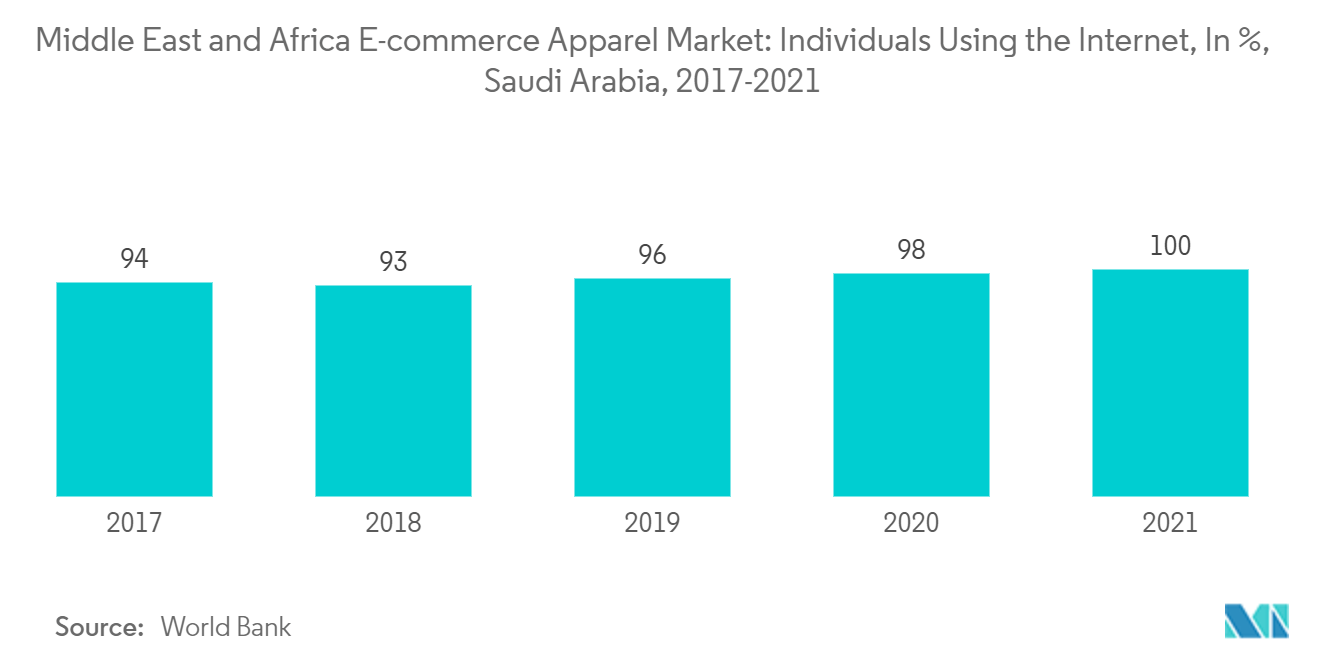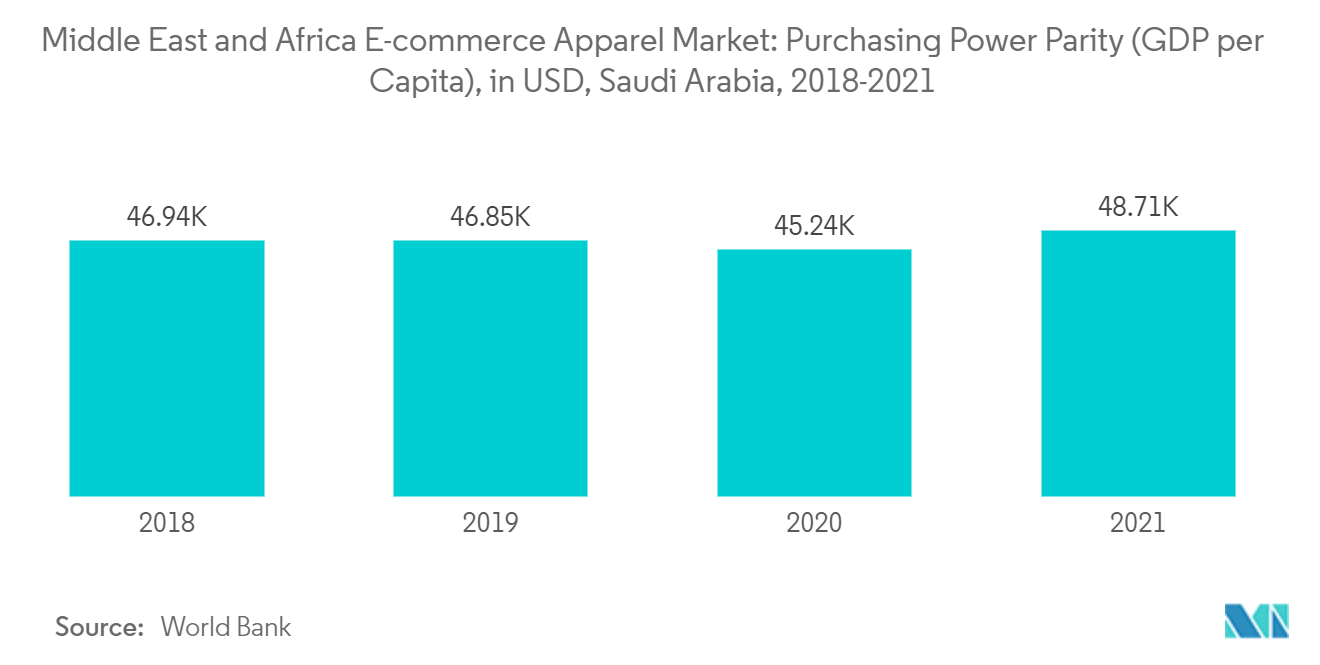Market Trends of Middle East and Africa E-Commerce Apparel Industry
Rising Internet Penetration & Increased Social Media Usage Boosting the Market
- Strong internet penetration in the Middle East and Africa has greatly aided in raising customer awareness of current fashion trends and various types of clothing. According to the World Bank data, internet penetration in Saudi Arabia reached 100% in the year 2021. Due to the increased usage of the internet, nations across the region have a substantial number of active social media users on various social media platforms, including Instagram, Facebook, Snapchat, and Twitter. Due to the increase in social media usage customers across the region have been getting exposure to various fashion trends and ad campaigns organized by various companies. The brand regularly monitors the performance of its ads throughout the advertising campaign and optimizes them depending on key metrics such as click-through rates, conversions, and engagement. This ensures that the brand maximizes the impact of its targeted advertising efforts and, if required, alters the strategy as needed.Strong Internet penetration in the Middle East and Africa has greatly aided in raising customer awareness of current fashion trends and various types of clothing. According to World Bank data, internet penetration in Saudi Arabia reached 100% in the year 2021. Due to the increased usage of the internet, nations across the region have a substantial number of active social media users on various social media platforms, including Instagram, Facebook, Snapchat, and Twitter.
- Due to the increase in social media usage, customers across the region have been getting exposure to various fashion trends and ad campaigns organized by various companies. The brand regularly monitors the performance of its ads throughout the advertising campaign and optimizes them depending on key metrics such as click-through rates, conversions, and engagement. This ensures that the brand maximizes the impact of its targeted advertising efforts and, if required, alters the strategy as needed.
- Additionally, fashion influencers across the region have been gaining popularity through social media, so different apparel brands have been collaborating with social media influencers to promote their brands. For instance, Mytheresa, an e-tail platform that offers womenswear, menswear, kidswear, and lifestyle products, partnered with Saudi influencer Nojoud Al-Rumaihi for a Ramadan and Eid campaign in March 2023. These industry-fashion influencers have been promoting various brands and e-commerce platforms which could, in turn, drive the market studied.
- Social networking is important in the current digital age. More consumers can be reached by marketers via social media marketing. The expansion of apparel sales through online channels has compelled online retailers to enhance the security and dependability of their website purchasing procedures, which has, in turn, played a significant role in the expansion of the market studied throughout the Middle East & Africa.
- For instance, in June 2022, The Foschini Group Ltd launched a new retailer channel, the 'omnichannel platform.' The apparel offered by the company was made available on this platform in South Africa. Hence, internet penetration has played a key role in driving the market studied.
- Additionally, fashion influencers across the region have been gaining popularity through social media so, different apparel brands have been collaborating with social media influencers to promote their brands. For instance Mytheresa, an e-tail platform that offers womenswear, menswear, kidswear, and lifestyle products partnered with Saudi influencer Nojoud Al-Rumaihi for a Ramadan and Eid campaign in March 2023. These industry-fashion influencers have been promoting various brands and e-commerce platforms which could in turn drive the market studied.
- Social networking is important in the current digital age. More consumers can be reached by marketers via social media marketing. The expansion of apparel sales through online channels has compelled online retailers to enhance the security and dependability of their website purchasing procedures, which has in turn played a significant role in the expansion of the market studied throughout the Middle East & Africa. For instance, in June 2022, The Foschini Group Ltd launched a new retailer channel, the 'omnichannel platform'. The apparel offered by the company was made available on this platform in South Africa. Hence, internet penetration has played a key role in driving the market studied.

Saudi Arabia as the Dominant Market Across the Region
- Saudi Arabia is the fastest-growing region in the Middle East & Africa e-commerce apparel market. The nation has been recording economic growth and a rise in purchasing power parity; hence, the e-commerce apparel market is expected to have ample growth opportunities in the nation. As per the World Bank data, the purchasing power parity of Saudi Arabia was USD 48,710.9 in the year 2021. As e-commerce platforms provide ease of accessibility and better discount offers as compared to brick-and-mortar shops, this, in turn, has given a significant boost to the e-commerce platforms that offer apparel and other items, further constituting a major market driver.
- Furthermore, urbanization has also been playing a major role in the expansion of the market studied. Urbanization has led to the development of better e-commerce sales logistics as well as ease of purchasing, and as the majority of the population across the Kingdom of Saudi Arabia is urban, thus, customers across the region tend to prefer e-commerce platforms for shopping that are expected to fuel the further expansion of the market. As per World Bank data, the percentage of the population in Saudi Arabia in the year 2021 was 85%. This demonstrates high accessibility to modern retail channels, including e-commerce platforms.
- Key players are also trying to increase their penetration by collaborating with regional distributors, gaining an edge over domestic players. For instance, in December 2021, Saudi Arabia's General Authority for Competition approved the joint venture between G Distribution B.V and Al Rubaiyat Co. for Industry & Trade Holding for the omnichannel distribution of Gucci products in the Kingdom.
- During the review period, LVHM also launched its multi-brand website to increase its accessibility among consumers. Additionally, strategic expansion by the existing market players through inorganic growth and innovative ease provided by tools such as 3D try-and-buy tools are expected to further assist the growth of e-commerce apparel across the region, which could lead to the expansion of the market studied.


